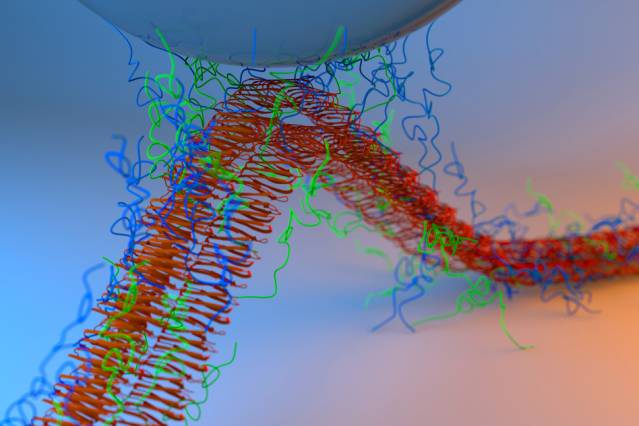 This image shows adhesion between the silica tip of an atomic force microscope and adhesive fibers made by fusing mussel foot proteins and curli amyloid fibers. Image:Yan Liang
This image shows adhesion between the silica tip of an atomic force microscope and adhesive fibers made by fusing mussel foot proteins and curli amyloid fibers. Image:Yan Liang
Researchers from MIT have designed and created new waterproof adhesives which can be used to repair ships or to heal surgical inclusions and wounds. The researchers drew inspiration from shellfish like barnacles and mussels, which secrete highly sticky proteins enabling them to adhere to ship hulls and rocks underwater.
Previously researchers have engineered E. coli bacteria in order to produce mussel foot proteins; however those materials were not as effective as natural adhesives. In this study, two different foot proteins were created from the bacteria and integrated with bacterial proteins known as curli fibers. These are fibrous proteins which can cluster together in order to form more complicated and larger meshes.
The bacteria were made to produce proteins comprising of curli fibers bonded to mussel foot protein 5 or mussel foot protein 3. After these proteins were purified from the bacteria, the team at MIT allowed them to incubate and form meshes that were fibrous and dense. The newly created material was a flexible structure that firmly adhered to wet and dry surfaces.
A lot of underwater organisms need to be able to stick to things, so they make all sorts of different types of adhesives that you might be able to borrow from.
Timothy Lu, Associate Professor of Biological Engineering and Electrical Engineering and Computer Science at MIT
The adhesives were then tested using atomic force microscopy and it was observed that adhesives clung to tips made of gold, silica and polystyrene. Adhesives made from equal quantities of mussel foot protein 3 and mussel foot protein 5 formed adhesives with higher strengths than those with another ratio or either of the proteins on their own.
The scientists at MIT are now trying to produce larger quantities of the adhesives and experiment with different mussel foot proteins. The team is also working towards engineering ‘living glues’, with are bacteria films that can detect faults in a surface and repair it by producing an adhesive. The research was published in the journal Nature Nanotechnology.